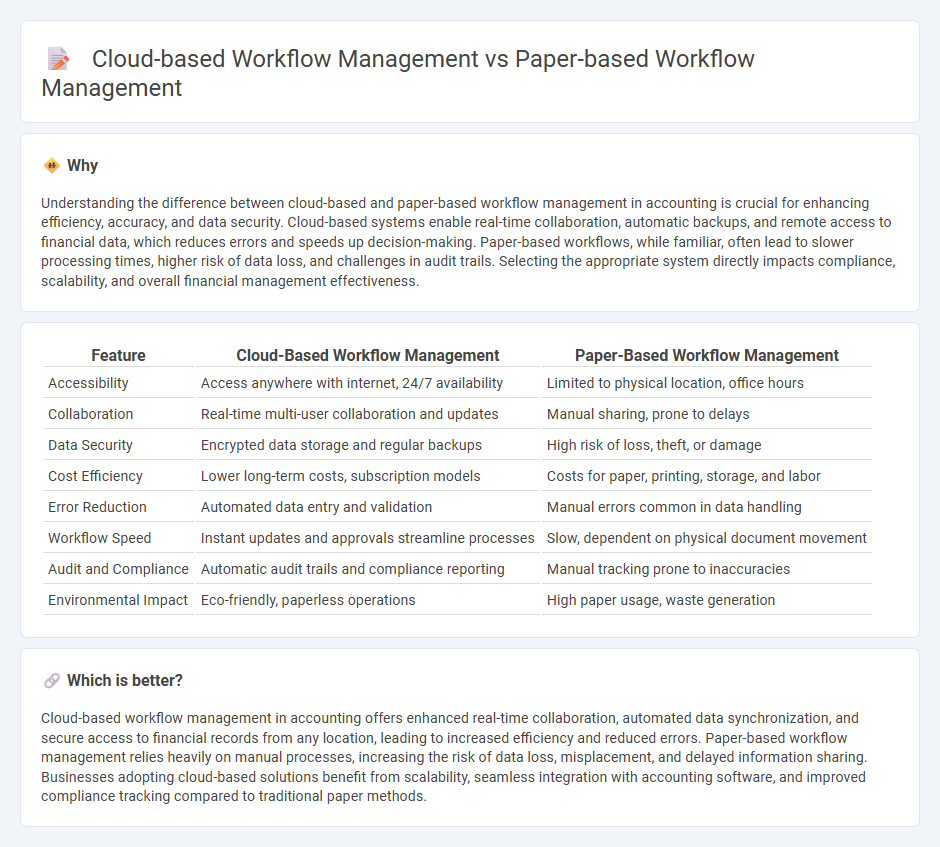
Cloud-based workflow management in accounting streamlines processes through real-time data access, automated task assignments, and seamless integration with financial software, significantly reducing errors and enhancing collaboration across teams. In contrast, paper-based workflow management relies on manual documentation and physical file handling, leading to slower processing times and increased risks of data loss or misplacement. Explore the advantages of cloud solutions to transform your accounting workflow efficiency and accuracy.
Why it is important
Understanding the difference between cloud-based and paper-based workflow management in accounting is crucial for enhancing efficiency, accuracy, and data security. Cloud-based systems enable real-time collaboration, automatic backups, and remote access to financial data, which reduces errors and speeds up decision-making. Paper-based workflows, while familiar, often lead to slower processing times, higher risk of data loss, and challenges in audit trails. Selecting the appropriate system directly impacts compliance, scalability, and overall financial management effectiveness.
Comparison Table
| Feature | Cloud-Based Workflow Management | Paper-Based Workflow Management |
|---|---|---|
| Accessibility | Access anywhere with internet, 24/7 availability | Limited to physical location, office hours |
| Collaboration | Real-time multi-user collaboration and updates | Manual sharing, prone to delays |
| Data Security | Encrypted data storage and regular backups | High risk of loss, theft, or damage |
| Cost Efficiency | Lower long-term costs, subscription models | Costs for paper, printing, storage, and labor |
| Error Reduction | Automated data entry and validation | Manual errors common in data handling |
| Workflow Speed | Instant updates and approvals streamline processes | Slow, dependent on physical document movement |
| Audit and Compliance | Automatic audit trails and compliance reporting | Manual tracking prone to inaccuracies |
| Environmental Impact | Eco-friendly, paperless operations | High paper usage, waste generation |
Which is better?
Cloud-based workflow management in accounting offers enhanced real-time collaboration, automated data synchronization, and secure access to financial records from any location, leading to increased efficiency and reduced errors. Paper-based workflow management relies heavily on manual processes, increasing the risk of data loss, misplacement, and delayed information sharing. Businesses adopting cloud-based solutions benefit from scalability, seamless integration with accounting software, and improved compliance tracking compared to traditional paper methods.
Connection
Cloud-based workflow management in accounting enhances paper-based workflow management by digitizing document storage and approval processes, increasing efficiency and accessibility. Integration of cloud platforms with traditional paper workflows enables real-time collaboration, automated data entry, and audit trails that reduce errors and improve compliance. This hybrid approach supports seamless transition between physical documents and digital records, optimizing overall accounting operations.
Key Terms
Source and External Links
3 Tips To Simplify Document Workflow Automation - Function-4 - This article outlines practical steps to transition from paper-based workflows to digital ones, emphasizing stakeholder engagement, mirroring existing processes digitally, and continual optimization after implementation.
Moving From Paper Based Processes To A Digital Workflow - DocTech - Discusses the importance of reducing paper use through digitization, using process mapping tools to visualize and improve workflows, and maintaining documentation of changes during the transition.
Transforming Slow, Paper-Based Processes into a Seamless Digital Workflow - Copliancy - Highlights how digitizing paper-based workflows centralizes document management, boosts accuracy and consistency, reduces errors and operational bottlenecks, making businesses more efficient.
 dowidth.com
dowidth.com